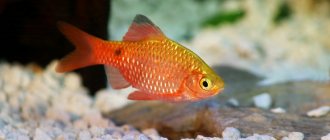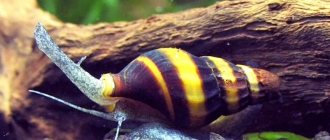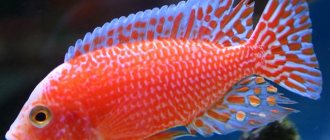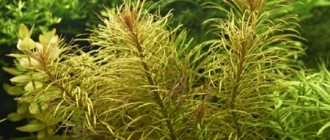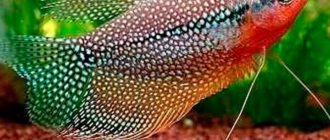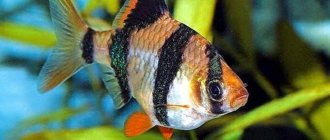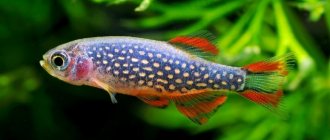Scarlet barbs (lat. Pethia padamya) are small, bright and very active fish. They chase each other all day long, sometimes they bully their neighbors in the aquarium, but they do it harmlessly, that is, they are considered non-aggressive, but at the same time they are constantly irritated and angry. This unpretentious fish can be kept in a community aquarium or with other types of barbs. Even a novice aquarist can take care of the creature.
Among aquarists, there are also the names ruby and Odessa barbs, the first is a literal translation of the color from the Burmese language (the word padamya), the second comes from the Ukrainian city of Odessa, where these barbs began to be sold in 1970-1971, and only around 2003 their true origins in Burma are known.
The fish's homeland is vast: southeast Asia, Sri Lanka, Pakistan, India, China, Nepal, the Himalayas, Thailand. There they live in slow-flowing muddy rivers.
Scarlet barbs - sexual dimorphism
The main distinguishing feature of the scarlet barb is a wide red stripe stretching along the entire body. This element of the outfit is typical only for males.
Scarlet barbs sexually mature at the age of six months. But the first sexual signs become noticeable already at 3 months of age. Males of the scarlet barb are slimmer than females and brighter in color, especially during the spawning period. As they age, the scales of males often take on a noticeable blue tint.
Females have a modest silver color, the red stripe is almost invisible. They have a fuller abdomen, often protruding downwards.
Description and natural habitat
Males of the Scarlet Barb are different from females. Their body is elongated, oval, compressed from the sides, the abdomen is light, the back is gray-green. The sides of the body are silver-gray, with a tint, and a scarlet stripe runs along it. It becomes brighter during the spawning period. The scales of the fish are clearly visible; there are black spots near the tail and above the chest, with yellow rings around them. The fins are gray, large, almost transparent with clear dark strokes. They do not have antennae, unlike other varieties of Barbs.
Females are also silver in color, but not saturated and their red stripe is barely visible, their abdomen is fuller, extended downwards. They are larger than males, in nature the size of individuals is up to 7 cm, males - 6 cm. In a home pond, the maximum size of fish is 5 cm. They live 2-2.5 years in nature, in an aquarium for 3 years or more.
The fish are active, mobile, omnivorous. They live in schools in their natural environment in fresh water, where there is a muddy bottom and a slightly alkaline reaction. They spend a lot of time searching for food at the bottom. Distribution area - quiet backwaters, dams in India, Sri Lanka, Nepal, Laos, Pakistan. Many fish were discovered on the Irrawaddy River (in Myanmar). They breed during the rainy seasons.
Photo gallery of Scarlet Barbs:
Keeping scarlet barbs in an aquarium
Scarlet barbs are very active fish, so a spacious aquarium with a bottom area of 80x30 cm, along the periphery planted with long-stemmed aquatic plants, preferably small-leaved and with a central part free for swimming, is recommended for keeping them.
Most of the time, a flock of barbs rushes around in the middle layers of the aquarium, periodically swimming into the thickets of plants.
Plants floating on the surface will add a more natural look to the aquarium and dim the lighting. With this lighting and against the background of dark soil, the fish look more attractive.
By their nature, scarlet barbs are schooling fish, so it is better to keep them in a group of at least 5-8 specimens. Only in a group will their behavior manifest itself to the maximum extent.
Scarlet barbs can be called a hardy species; they can easily live even in an unheated aquarium, as they can easily tolerate a gradual decrease in temperature to 15°C, but even at high temperatures (28-30°C) they feel quite good. The temperature optimum for them lies in the range of 18-24°C. As for the chemical parameters of water, we should limit ourselves to the following values: pH 6.5-8.0 (slightly alkaline and close to neutral water is optimal), total hardness from 5 to 25 dGH.
We should not forget the main rule, which is true for the vast majority of fish species: any changes in the values of water parameters should occur as smoothly as possible, especially with regard to pH.
Scarlet barbs are peace-loving fish, but despite this they are capable of plucking the fins of their slower neighbors from time to time. Therefore, it is better to keep them with the same active, proportionate species or with small peaceful cichlids like pelvicachromis and apistograms.
The best choice as neighbors would be species originating from the same natural biotopes as scarlet barbs . Many fish found in the Ayeyarwaddy Basin are widely represented in the pet trade today, for example: firefly zebrafish (D. choprae), pearl zebrafish (D. albolineatus), orangefin zebrafish (D. Kyathit), Pethia stoliczkana, P. tiantian, P. Ticto, Acanthocobitis Botia, Schistura vinciguerrae, Lepidocephalichthys berdmorei and Crossocheilus latius and some others. They are not interested in bottom-dwelling fish like catfish and loaches.
In the aquarium, scarlet barbs lead an active lifestyle. In the struggle for females and a higher position in the hierarchical ladder, fights constantly occur between competing males, which can be interesting to watch. Such fights are of a tournament nature and end without visible consequences for both opponents.
Males often stage spectacular races in the aquarium, in which the dominant individual is always the winner. Having finished sorting things out, the males begin to pester the females, persuading them to spawn.
Scarlet barbs in the aquarium
Adviсe
- When buying fish, look at its external condition and mobility. Barbs are tireless swimmers, so if the fish in the store is sluggish and inactive, then it is most likely sick. But puntius rarely get sick because they have good immunity.
- When choosing fish, pay attention to the scales. It looks like a pronounced grid and gaps in it indicate health problems.
- The beauty of fish is especially evident in a container with dark soil and diffused light from vegetation floating near the surface.
- Do not overload the aquarium with decorations; it is better to leave more space for swimming.
Breeding scarlet barbs in an aquarium
This fish, pleasant in all respects, is one of those species that can be safely recommended to beginners. When optimal conditions are created for them and proper feeding, once they become sexually mature, they are almost always ready to spawn and often do this right in the general aquarium. Therefore, it makes sense for a novice amateur to gain experience in fish breeding and scarlet barbs too.
If spawning occurs in a general aquarium, then only a few fry manage to survive.
For targeted breeding of scarlet barbs , you should use a separate aquarium. Before spawning, the spawners are placed in different containers for one to two weeks. During this time, with abundant and varied feeding, the females collect eggs.
Both pair and flock breeding are practiced. The spawning tank can be small (about 15 liters) for a pair of scarlet barbs , or more spacious (from 30 liters) for a group of 8-12 individuals, while the ratio of females to males is selected at the rate of 1:2.
The overall hardness of water (GH) is not of fundamental importance; fish will spawn in both soft and medium-hard water. Spawning is more productive in water with a hardness of no more than 8dGH. But the spawning substrate is crucial; without it, scarlet barbs will not spawn. As such, live small-leaved plants or their plastic analogues are used; even a bunch of synthetic threads, preferably green, will do. The lighting is poor. To create water movement, weak aeration and filtration are necessary. To stimulate spawning, the temperature in the spawning tank gradually rises to 25°C.
A separator net is installed at the bottom, since producers are not averse to feasting on their own caviar in the intervals between spawning cycles.
As a rule, spawning occurs in the morning, in thickets of small-leaved plants and lasts about 4 hours. The spawning of scarlet barbs is a spectacular sight. A male in a bright outfit curls around the female, gradually pushing her into the thickets of plants; when he succeeds, the producers press closely to each other, as a result of which another portion of eggs appears. One adult female (depending on age and size) is capable of laying more than 300 eggs. The caviar is relatively small, transparent, and therefore unnoticeable. Some of the swept eggs settle on the plants, and some fall to the bottom.
At the end of spawning, the spawners are immediately removed. The water level is reduced to 10 cm, replacing 1/2 of the volume with fresh water with similar parameters.
At a temperature of 25°C, the incubation period lasts about 36 hours, after which the first larvae appear, which after a day begin to swim around the aquarium in search of food.
Ciliates and “live dust” serve as starting food for fry. After just a few days (4-5), the fry are able to take Artemia nauplii and other food commensurate with them. In the absence of artemia, scarlet barb fry can be fed with egg yolk and dry food for fry, but on such a diet it is unlikely that the fish will be brightly colored.
At one month of age, it is recommended to introduce food of plant origin into the diet of juveniles.
Scarlet barbs easily form hybrids with related species, in particular with Puntius stoliczkanus.
Compatibility with other aquarium fish
The scarlet barb, despite its hot temperament, is compatible with most aquarium fish of comparable size. Fights can occur among themselves if there are enough barbs. Therefore, it is better to keep them in small flocks of eight to ten pieces . If necessary, weak fish should be placed in another aquarium.
Fish with long fins may have problems living together. Such as the leisurely Angelfish and Telescopes, as well as the Cockerels. Curious and restless residents of Odessa will simply bite the fins of these fish. They behave calmly with others; even if they bully, it does no harm.
Diet of scarlet barbs
In nature, the diet of scarlet barbs consists mainly of small invertebrates, and to a lesser extent aquatic vegetation and detritus.
In an aquarium, fish consume all types of live and frozen food, various dry flakes and granules, which preferably contain plant components. In the absence of the above-mentioned feeds, you can use any of their substitutes: small pieces of sea fish, squid, scraped beef heart, etc. In an aquarium, scarlet barbs often nibble plants with delicate leaves, usually without causing significant damage to them, but sometimes desperate vegetarians are found among scarlet barbs .
This problem can be solved by introducing plant foods into the fish diet in the form of finely chopped dandelion greens, lettuce or spinach, and crumbs of stale wheat bread, pre-scalded with boiling water. Riccia or duckweed can be placed on the surface of the water, which will also distract the barbs from more valuable plants. You can use hard-leaved flora such as Anubias and Echinodorus in the aquarium; do not touch fish and Cryptocorynes because of their bitter taste.
Scarlet barbs are prone to gluttony, especially females, so you should strictly dose the amount of food. Barbs take food equally well both at the surface of the water and from the bottom.
You should not give the fish dry gamarus, since once in the stomachs, it tends to push the fish to the surface, as a result of which they are forced to swim head down for some time. It is better to use sinking flakes and granules.
What kind of fish is this: its homeland, why is it called Odessa?
The scarlet barb is a small fish, up to 6 centimeters in size. Has several names. The Latin names of this brightest representative of barbs are Barbus tikto, Puntius sp., Scarlet Barb or Odessa Barb. In Russia it is known as the Scarlet Barb, Tikto, or Odessa Barb. The many names are due to the uncertainty of the origin of this barb.
Southeast Asia, or more precisely Burma, is considered its homeland. It first appeared on the territory of the former USSR in the early 70s in Odessa, where one of its names came from.
The scarlet barb belongs to the species Barbus, order Cyprinidae, suborder Cyprinidae, family, Carpidae. Similar fish are found from India to Vietnam and are smaller in size than aquarium fish, up to 4 centimeters. It is assumed that the first Scarlet were caught in a mountain river, at an altitude of about three kilometers, in Burma (now Myanmar). In nature, it lives in rivers with fairly hard, turbid water with a small amount of vegetation and a rocky bottom.
Appearance: photo and description
Next, check out the photo of the scarlet barb:
The body shape of the Odessa Barb is similar to the Fire Barb. It stands out from other barbs for its brightest color. A wide scarlet stripe from the head and extending to the tail gives this fish its name. Black spots are present near the gill cover and tail.
The spot near the gills may look like a small transverse stripe, and near the tail it may be barely noticeable.
The back is light, can iridescent greenish-brown. The belly is silvery. Males are brightly colored. Female iris have light yellow eyes, while males have red eyes. In females, the scarlet stripe is barely noticeable, and may disappear during the breeding season . The fins are large and transparent. The male has black spots on the dorsal, ventral and anal fins. In females these spots are pale or absent altogether. The pelvic and anal fins of females are orange.
The differences between male and female are visible in the photo:
Temperament and peacefulness
The mischievous and active ones constantly move around the aquarium, creating a cheerful and vibrant round dance. Despite their activity, they are quite peaceful fish. They do not show aggression towards others, only hectic curiosity.
Lifespan
Scarlet retain their activity throughout their entire life. The average lifespan is three years, but if the diet is followed, they can live up to six years. Obesity can contribute to decreased life expectancy. Barbs are gluttons, so feeding rules must be followed.
Scarlet barb diseases
In general, scarlet barbs are a robust species, little susceptible to bacterial diseases. But if the conditions of keeping and feeding are not met, fish can suffer from diseases such as mycobacteriosis (tuberculosis) and ichthyophthyriosis. Moreover, mycobacteriosis often manifests itself in the most aggressive form, in the form of weight loss and characteristic drying of the back, which makes the fish look bony and big-headed, and does not suffer from a lack of appetite, but ultimately dies. But ichthyophthyriosis, when correctly diagnosed, can be easily and quickly cured.
It’s a pity that today the popularity of this wonderful fish is not the same as before. Most likely, this is due to the fact that pet stores sell juvenile scarlet barbs , which have a rather inconspicuous coloration compared to the same fiery barbs and sumatranus, and people who have no idea about the adult coloration of the species avoid them. But the scarlet barb is superior to many related species in its simplicity of keeping and the brightness of its mating color and can become a true decoration of any decorative aquarium.
Feeding
Under natural conditions, the Odessa barb feeds on insects and their larvae in the silt. When kept in an aquarium, it is unpretentious to food and eats everything. Any type of food is suitable for Puntius: frozen, dried or live. But a certain percentage of the diet consists of plant foods. If you feed your fish only protein foods, this will lead to diseases.
Fish have a good appetite, which often leads to overeating. Barbs are able to swim and eat all day long, but it is better to know the measures in feeding the fish and feed the fish 2 times a day.
View this post on Instagram
Posted by Pascal Wolterman (@pascalwolterman) Nov 8, 2021 at 10:53 am PST
